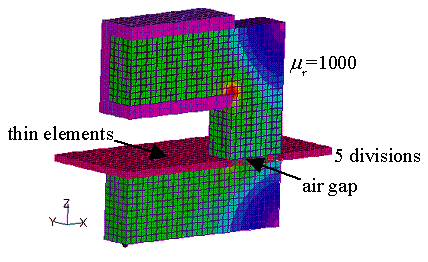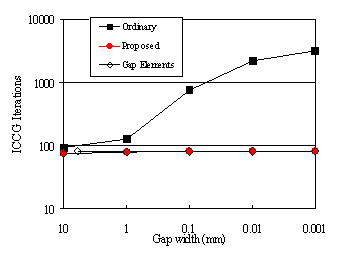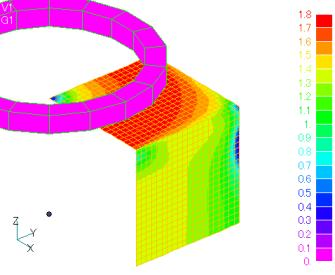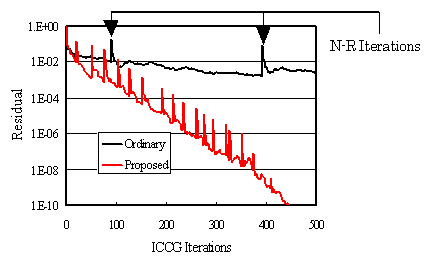Improved convergence of flat and elongated elements
- TOP >
- Analysis Examples by Functions (List) >
- Improved convergence of flat and elongated elements
Summary
In the finite element method, the presence of flat or elongated elements (Fig. 1) in the mesh generally deteriorates the matrix properties and slows down the convergence of the ICCG method, etc. In EMSolution, when the elements are extremely flat, they can be replaced by GAP elements, which are two-dimensional elements. However, there are many cases in which you may want to use three-dimensional elements. For example, when analyzing the motion of a plunger, the gap may be extremely small, but the GAP element is not supported in a coupled motion analysis. Also, when a two-dimensional mesh is stacked to form a three-dimensional mesh, very flat elements are often created in the air region.
Therefore, EMSolution has introduced a method to improve convergence in the case of very flat or elongated elements. Here, we will introduce the effect of this method through example analyses.
そこで、EMSolutionにおきましては、このように非常に偏平あるいは偏長な要素が含まれる場合の収束性を改善する方法を導入しました。ここでは、解析例を通じてその効果を紹介します。
Explanation
First, we show an example of "analysis using gap elements". Fig. 3 shows the convergence of the ICCG method with respect to the gap spacing. Using this improved method, the convergence frequency does not increase even when the gap spacing is set to 1 $\mu m$ using 3D elements, showing very good convergence characteristics.
Next, we show the analysis of the Box Shield model (Fig. 4) used for verification at the IEEJ. A 0.2 $m$ square rectangular shield (0.01 $mm$ thick) is subjected to a magnetic field by the upper and lower coils. It is divided into 10 layers in the thickness direction. The mesh is an orthogonal grid created by stacking two-dimensional meshes in three dimensions and contains very flat and elongated elements. Some elements, especially in the outer air region, have aspect ratios reaching 20,000. A nonlinear static magnetic field analysis is performed and the magnetic field in the iron material (SS400) reaches a saturation magnetic field. Fig. 5 shows the convergence process, and Table 1 shows the number of elements and other analysis parameters and calculation time. The number of iterations of the Newton-Raphson method is not so different from the conventional method without this improvement, but the number of iterations of the ICCG method is about 1/24, which is very small. As a result, the ICCG method can solve a problem more than 9 times faster, taking less than 4 minutes instead of the 34 minutes required by the conventional method. Note that the number of unknowns and the number of matrix nonzero elements are slightly higher with this improved method, and the memory used increases.
Table 1. Analysis Parameters and Computation Time
| Ordinary | Proposed | |
|---|---|---|
| Number of elements | 125,000 | |
| Number of nodes | 132,651 | |
| Number of unknowns | 365,050 | 374,370 |
| Number of Non-zeros | 6,016,122 | 7,606,586 |
| N-R iterations | 25 | 19 |
| Total ICCG iterations | 13,410 | 546 |
| CPU time (s) | 2,056.3 | 223.1 |
From the above, we believe we have demonstrated the usefulness of this improvement method. This improvement method seems to be particularly effective for flat and elongated elements in air. It can be applied to hexahedral and triangular prismatic elements. Of course, there is no difference in the calculation results with and without this function. This function has been available since EMSolution ver 10.1.1.
The rest of this page is for members only.
Analysis Examples by Functions
Convergence property improvement and speed-up methods
- Problems with flat tetrahedral elements and their countermeasures
- Node-second-order edge-first-order elements
- Joining hexahedral and tetrahedral elements
- Improved convergence of flat and elongated elements
- Fast convergence to steady-state solutions of time-periodic problems
- Steady-State Analysis of Induction Motors Using a Simplified Time-Periodic Method
- Steady-State Analysis of Rotating Machines by Simplified Multi-Phase AC EEC Method
- Parallel computing capability with OpenMP
- Restart analysis function for changing convergence conditions
©2020 Science Solutions International Laboratory, Inc.
All Rights reserved.







